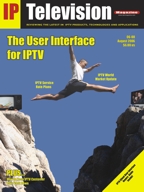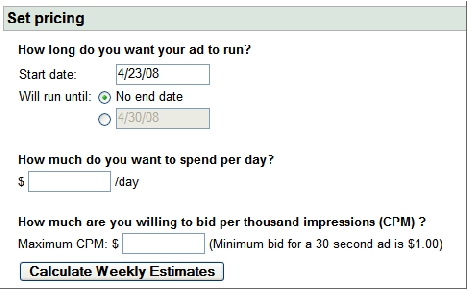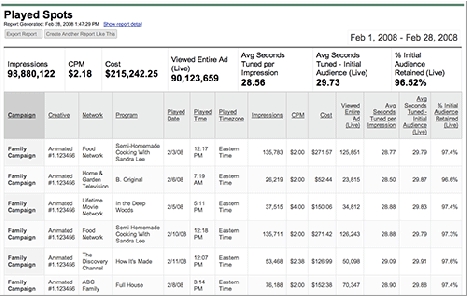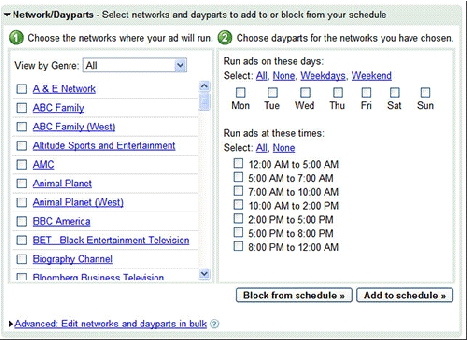|
Google has setup a TV advertising web portal which makes television advertising easy to setup, provides better ad targeting, and creates more profits for advertisers and television networks. With just a few clicks of a mouse, companies can display their television ads on televisions around the world!
Companies may not advertise on television because it can be complicated to setup and is often perceived to have high cost. It is also often difficult for companies to identify and track which geographic regions and programs are most effective for certain types of television commercials.
Using Google's advertising web portal, companies can match their TV ads with the right types of viewers. This results in more advertising sales (more ad revenue for the broadcaster), and provides customers with ads that are more targeted and of interest to them.
Setting up and managing television advertising via a web portal allows advertisers (or their agencies) to setup their own television marketing campaigns. To create a TV advertising web portal, Google has updated their AdWords advertising interface. This means that companies that are familiar with Google Adword advertising can setup their own TV advertising campaigns in minutes (assuming they have TV commercials on hand).
The advertiser can select the television networks they desire, the days and times (dayparts) they want their commercial to play, and the programs they want (and don't want) to be associated with. The advertisers bid for their ads to be inserted, sets budgets for each campaign, and can access detailed reports showing how many ads have been inserted and the effectiveness of each one.
Campaign Control
Campaign control is the setup of campaigns, ad groups, and distribution options for promotional messages. Google television campaign controls include ad bidding, television network selection, and program restrictions. |
Ad Bidding
Ad bidding is the process of assigning bid amounts that are associated with specific advertising messages, along with the criteria that will be used to enable the bidding process. When the ad bidding criteria are fulfilled, such as when the network and program for a campaign are available, the highest bids are selected and the advertising message(s) may be inserted.
Advertisers set the maximum amount they are willing to pay per thousand viewers (maximum CPM). The advertiser only pays the bid from the next highest bidder lowering the cost to the advertiser.
Television advertising rates can dramatically vary as they are based on the number of people that view a commercial. Typical rates range from approximately $2.00 to $6.00 cost per thousand viewers (CPM). Google's minimum bid is $1.00 per thousand.
Ad Budgeting
Ad budgeting is the estimation and allocation of resources that should be made available for the selection, display and insertion of commercial messages into a broadcast channel (such as a television channel) or media system (such as a web page).
The Google TV advertising web portal allows the advertiser to set a budget for their marketing campaigns. Bids can be increased or decreased after a campaign is started and the advertiser can set a daily spending amount for each campaign.
To help an advertiser to determine how much to spend, a traffic estimator can be used. A traffic estimator is an application or service that predicts the amount of usage or activity that may occur as a result of the criteria provided (such as the amount of budget allocated in an advertising campaign). The Google TV advertising traffic estimator is a utility tool that can forecast the amount of viewing or broadcasting an ad in a marketing campaign will generate based on criteria such as bid amounts, selected networks, or other criteria. |
|
Figure 1.1 shows how an advertiser can setup budgets and bid on television advertising with the Google TV system. Google allows the advertiser to setup campaign run time periods during which ads may be inserted if bids have been accepted. This example also shows that the Google TV web portal provides the advertiser with an estimate of how much the campaign will cost using the settings.
Television Network Selection
Television network selection is the ability of a company or system to identify which broadcast network it desires to use. The web portal enables the advertiser to select specific networks or groups of networks of similar types (genres).
Program Restrictions
Program restrictions are a set of rules and processes that can inhibit or block the use or insertion of media into specific programs based on predefined characteristics (such as not allowing the insertion of television commercials into programs that contain adult content or violence). |
Campaign Measurement
Campaign measurement is the gathering of delivery and event information that identifies when a campaign has occurred, the delivery details of the campaign, and the events that relate to the viewing of the campaign ads. The Google TV advertising system gathers and confirms ad delivery information through a variety of techniques including the use of anonymized set top boxes (STBs) which can provide tuning metrics.
Anonymized STBs
Anonymized set top boxes are devices that can select, control, and interact with content without revealing their identity. The use of anonymized STBs allows for the gathering of usage data while maintaining the privacy of the viewer. |
|
Tuning Metrics
Tuning metrics are measurements of channel selection (which channels a receiver is tuned to) that can be used to identify usage characteristics (such as the changing of a channel in the middle of viewing a media program).
Reporting
Played spot reports identify where and when television ads have been inserted. The Google advertising system uses special TV set top boxes throughout the country which allow for the monitoring and verification of television ads that have run.
The TV advertising web portal gathers information in real time allowing the advertiser to see when viewers tune in to an ad and how they react to it (are they tuning out) as well. Viewer measurements occur in one second increments.
Google's TV ad system provides detailed reports with second by second viewing habits of TV commercials to allow the selection and optimization of television campaigns.
To help determine if campaigns have been successful, the commercials
can be designed to |
use unique phone numbers, web pages, or coupon codes that allow the tracking of response rates to television advertising campaigns.
Figure 1.2 shows a sample Google TV advertising report. This report shows the number of ads played, cost per thousand viewers (cpm), total cost, number of viewers that watched the entire ad, average amount of time viewers spent watching the ad, and the percentage of viewers who wathed the entire ad.
Television Ad Campaign Operation
A television ad campaign is comprised of marketing activities that send advertising messages to customers about the products, services, and options that are offered by a company through the insertion of content into television channels or programs. |
|
Genre Selection
Genre selection is the ability of a company or system to identify categories of desired or authorized program content.
Ad Run Times
Advertisers can select the day as well as the time within the day (dayparts) during which they'd like their commercials to run.
Day Part Selection
Day part selection is the ability to select, within a day, a range of times during which a program, commercial, or service can run.
Network and Program Selection
Advertisers can select specific networks and programs to use to run commercials. |
Figure 1.3 shows how an advertiser may select the specific networks, days of the week, and time periods that a television ad may show. Google allows the advertiser to select which networks or which network genres they want to use. The advertiser can also select desired days and time periods (dayparts) during which ads will run.
Ad Production
Television ads that are submitted to Google can come from existing commercials or television commercial production companies, or companies can create their own commercials. Existing commercials must be converted to a digital format that Google can accept.
It is possible for advertisers to make their own television commercials. Google provides links to resources for free and low cost production tools. If advertisers choose to produce original commercials, Google's editorial requirements must be met. |
|
Ad Creation Marketplace
The creation and production of a television commercial can be complicated and expensive. To overcome this, Google created an ad creation marketplace which identifies qualified televison commercial production companies and their capabilities to potential advertisers.
An ad creation marketplace is a group of media development companies that can produce advertising messages. Commercial television ad production involves concept creation, script writing, video production, voice-over talent, and editing.
Ad creation using a production firm can cost as little as $1000. Ads that include graphic effects, licensed content (such as popular music), and skilled actors can cost significantly more. The turnaround time for a television commercial production can range from a few days to a few weeks.
Ad Submission
Ad submission is the process of providing an advertising message to broadcasters or communication providers for distribution through their systems. Ad submissions may be reviewed for approval before they are broadcasted or made available for viewing.
Ad submission on the Google system involves the transfer of the commercial in defined digital media formats. Video conversion may be necessary to change the format of a commercial to a format that can be transferred to the advertising network.
Ad Regulations
There are several regulations that apply to television advertising which can vary based on the location of the ads. The Federal Trade Commission (FTC) requires disclosures for advertisements of certain products or services. For those ads that are targeted towards children, the Children's Advertising Review Unit (CARU) imposes a self-regulatory guideline. |
Ad Optimization
Ad optimization is the adjustment of advertising components to increase the effectiveness of a promotional campaign.
Tuning behavior is the channel selection activities that occur during a viewing session.
Editorial Policies
Television commercials require editorial approval before authorization to broadcast is granted. The editorial policies define acceptable types of content and how they should be formatted or presented including content and legal restrictions.
Content Restrictions
There are some restrictions placed on the content of ads. Ads may not contain adult content, should not impersonate celebrities without permission, must have authorization to use copyrighted content from other sources, and must meet various other content restriction requirements.
Legal Regulations
The ad must also comply with all laws and required disclosures. Laws and regulations can vary from one jurisdiction to another. Some regulations may relate to the offering of sweepstakes and contests, the sale of prescription drugs, and political ads. |





